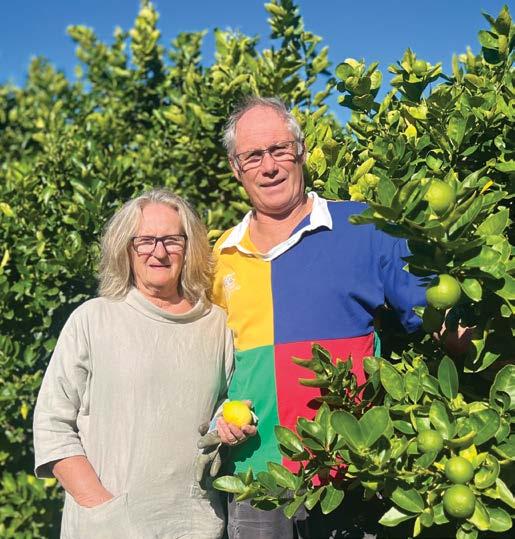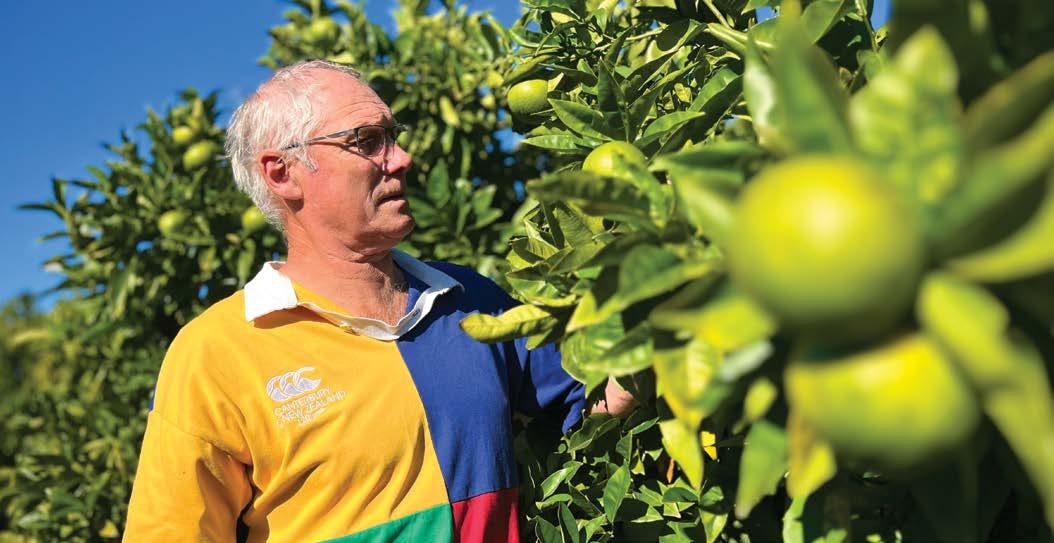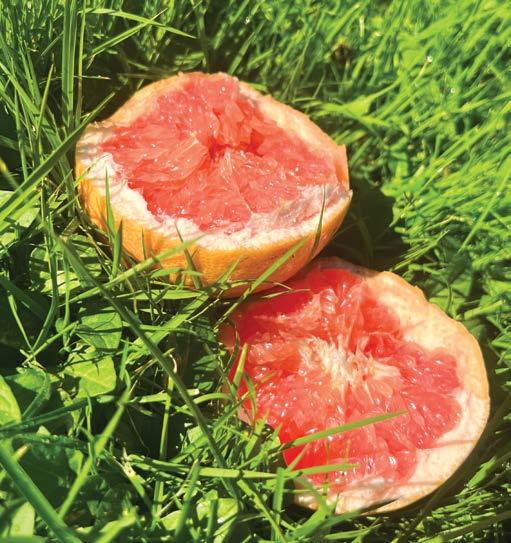
8 minute read
'WHERE WE WERE MEANT TO BE'
The chance to develop a mixed-variety citrus orchard near Gisborne has given a former Wairoa couple an enviable lifestyle after some pretty taxing times.
By Kristine Walsh
“We’d been looking all over the country for a lifestyle block with the potential to have a business and ended up finding this one very close to home,” John Ross says of the Matawhero property.
“It was already planted in citrus and we were struck by how it was laid out. And how, from the house site, you can survey the entire orchard so when the trees are in flower it is a stunning, scented spectacle.”
It was a picturesque conclusion to a sometimes ugly journey for John and wife Sophia who, 20 years ago, were happily working the Waiatai Valley sheep and beef station that had been in the Ross family for a century.
Even for farming folk used to their fair share of challenges, times got extra tough.
In 2007, the then-50-year-old John had an accident while burning-off blackberry, suffering burns so serious the Eastland Rescue Helicopter had to carry out an emergency uplift to Gisborne Hospital, from where he was transferred to Waikato for specialised treatment.

After months of hospitalisation and rehabilitation he returned to work. But, while knocking around the farm, he found it difficult to protect his fragile scar tissue.
And if that wasn’t tricky enough, the couple’s challenges ratcheted up many notches when they were blasted by the Hawke’s Bay deluge of April 2011, their station being among the heaviest hit in a region that was hit very, very hard.
That led to a wall of recovery work and between the injury and the flooding, the couple were prompted to seek out a less demanding opportunity.
But it was not a direct migration from Wairoa to Gisborne: they sold the farm in 2013 and moved into their Māhia Beach home, where they remained for two more years after buying the Matawhero property in 2016.
“The former owners agreed to stay on to manage the orchard while I worked in real estate and land management, so it was a great solution for us,” says John. “Sophia had been growing limes back in Wairoa but I didn’t have any experience at all so it was a great chance to come over and work under their guidance.”

When they did make the permanent move to Matawhero, Sophia took the lead for three years until John could devote himself to the orchard full-time.
Between them they had taken on a 5.53ha orchard planted in Encore, Richard’s Special and Satsuma (Okitsu) mandarins, with pockets of Tahitian and Bearss limes, Valencia and Navel oranges, and young Star Ruby grapefruit.
“Basically, we just set about making the best of what we had,” John says. “We did add some artificial shelter and increased plantings in some vacant areas, but the real focus was on good land and tree management to improve production.”
The mix of plantings creates a manageable harvest flow and even gives the Rosses a bit of quiet time in early winter to take some time out for themselves.
“But it certainly keeps us busy,” says John. “We’ll start harvesting the Richard’s Specials in August then dive into the Encore and work through the Valencia, limes and grapefruit, with things slowing down by the end of February.”
Like any endeavour, he says, there have been some niggles along the way.
For example, rigorous testing has failed to identify why some of the limes aren’t producing as well as they could.
Then there was that hairy moment when, during 2023’s Cyclone Gabrielle, he stood on the stopbank at the rear of the property and watched as the Waipaoa River roared and rose, triggering some pretty anxious memories.
“We were getting geared up to evacuate equipment but, just in time, the river level started going down,” he says.
“It turned out the research we’d done before buying the property paid off in terms of protection from flooding, but others around us were very, very badly affected.”
The resulting high water table did, however, have an impact on the trees’ flowering and fruitset, with some fungal issues thrown in for good measure.
“So it’s been great to get back to a proper season this year with decent tonnages of good quality fruit,” says John.
“I guess it’s just that great farming leveller… the wind and rain don’t care how much work you have put in.”

The Rosses must be doing something right as they have been award winners across multiple categories at the Freshies, the annual awards organised by their packing/ marketing representatives, First Fresh.
And they plan to keep on doing it.
“I love working with the trees and learning all I can about citrus management. There’s a lot more to it than I first thought but we’ve had a lot of great advice from some really helpful sources,” says John.
“On a small block like ours you can do as much or as little as you want but the more you do, the bigger the reward.”
Meanwhile, and though the scars remain, John believes there is a glimmer of silver lining to that horrible accident back in 2007.
“If I hadn’t been for that ride on the rescue helicopter we wouldn’t have started on the journey that brought us to where we are today,” he says.
“We very much enjoy our life here which is close to the city, where we wanted to be, on flat land with soils in which you can grow just about anything.
“The place just had something very special about it and we feel it’s where we were meant to be.”
SEASON SHOWS SIGNS OF RECOVERY FOR CITRUS

Two years after Cyclone Gabrielle wreaked havoc on many citrus crops, grower resilience has borne fruit with some great results unfolding in the 2025 harvest.
Citrus NZ chair Ian Albers says that, by mid-May, picking of Satsuma mandarins was coming to a close in the major growing area of Kerikeri; was in full swing in the equally-productive Gisborne; and was also underway in Matakana, just north of Auckland.
Overall, quality was looking good despite some patchy rainy weather in Gisborne and massive rainfall in Northland, he says, and fruit was tasting great as growers transitioned into midseason varieties of Satsumas.
At that time lemons were also well underway in all growing regions, with strong supplies of good-value Meyer and Yen Ben putting paid to the temporary shortfall experienced in the space between the start of harvest, and the running out of fruit imported from the United States.
“Export packing, too, is underway and this will run through until July with the main markets being Japan and the United States,” Ian says. “And while it is unclear what impact proposed tariffs will have on lemons heading to the United States, being a niche item in this market we don’t expect demand to drop away, even if the price is slightly increased.”
Speaking of good value, by mid-May lime harvesting was in full cry and fruit was on the shelves at around $6 a kilogram – well down on earlier years – largely due to increased imports, most from Viet Nam.
Those reduced returns are certainly tough on growers, Ian Albers said. “But on the flipside we are seeing a large increase in lime consumption and that’s great for consumer engagement.”
As a born-and-bred Mainlander, he was particularly looking forward to the grapefruit harvest that was due to start by the end of the month.
“Back in the day when making your own marmalade was a big deal, we’d see strong early demand and even marketed a green-tinged ‘marmalade grade’ that home cooks were pretty keen on,” he said.
“Given it can interfere with some people’s meds, grapefruit can get a bit of a bum rap, but in my view you can’t beat a half-grapefruit sprinkled with sugar and left in the fridge overnight.”
Last on the short-term roster is Navel oranges, which were showing good colour and are due for harvest from mid- to late-June.
“There has been imported fruit to fill the gap but we know how much consumers love a good, sweet New Zealand Navel, so they’ll be looking forward to that fruit coming on stream.”










